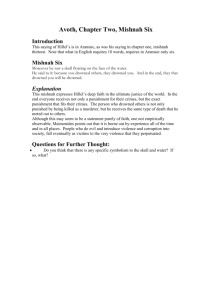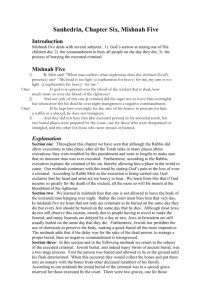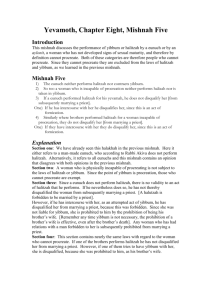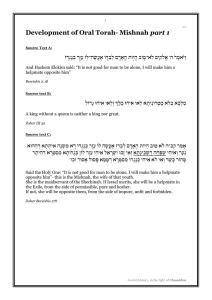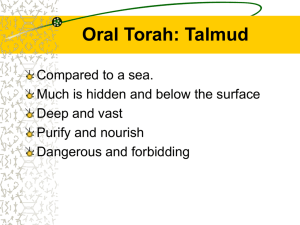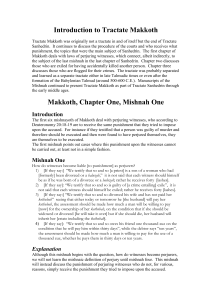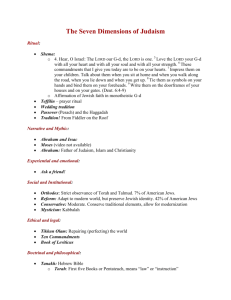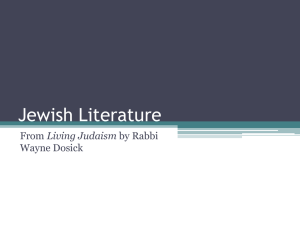E M : t
advertisement
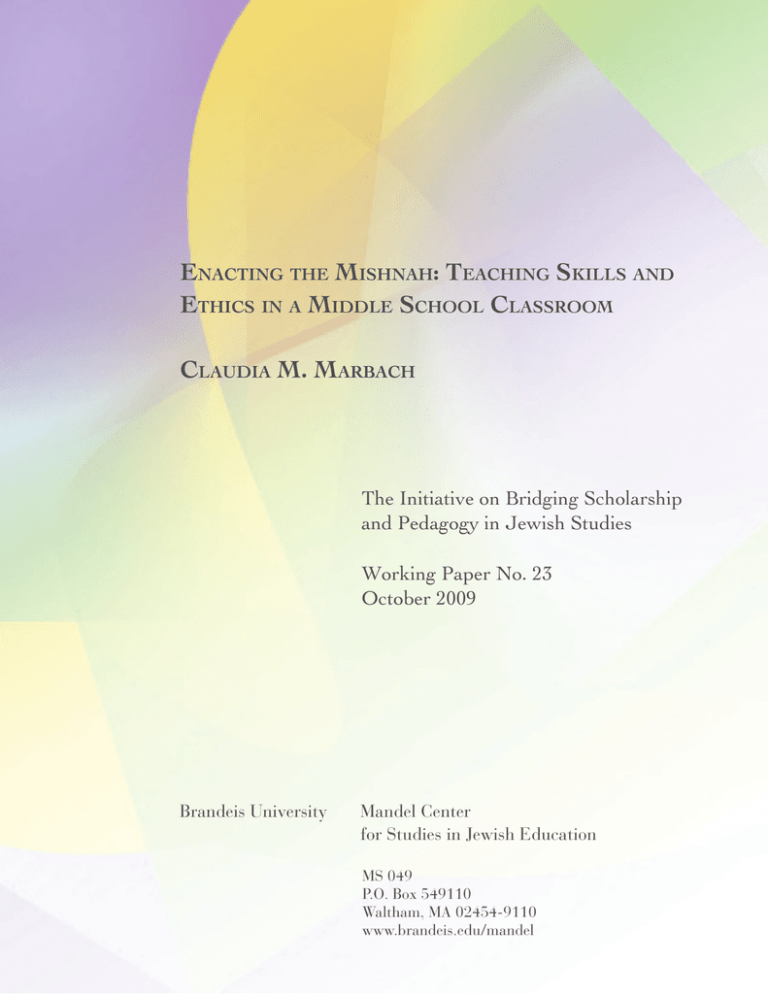
Enacting the Mishnah (Bridging Initiative Working Paper No. 23) • 1 Enacting the Mishnah: Teaching Skills and Ethics in a Middle School Classroom Claudia M. Marbach The Initiative on Bridging Scholarship and Pedagogy in Jewish Studies Working Paper No. 23 October 2009 Brandeis University Mandel Center for Studies in Jewish Education MS 049 P.O. Box 549110 Waltham, MA 02454-9110 www.brandeis.edu/mandel Enacting the Mishnah (Bridging Initiative Working Paper No. 23) • 1 Enacting the Mishnah: Teaching Skills and Ethics in a Middle School Classroom Claudia M. Marbach Abstract Why would middle-school students want to learn Mishnah? Why would teachers want to teach it? In this paper, the author presents her method of teaching Torah She-ba’al Peh in a pluralistic middle school, emphasizing ethics and experiential learning, towards three pedagogic goals: giving the students (a) a grounding in ethical behavior based on Jewish practice (b) the basic skills to continue the study of Mishnah, and later Gemara (c) a sense of rabbinic Judaism as a complex system with contemporary relevance. I. Introduction In this paper, I describe my method of teaching torah she b’al peh (Toshba) in a pluralistic middle school. I have developed a curricular unit based on a few key topics, which emphasizes ethics and experiential learning. The goal of the unit is threefold: to give students (1) a basic knowledge of ethical behavior based on Jewish practice (2) the basic tools to continue the study of Mishnah and later Gemara, and (3) a sense of Judaism as a complex system, many values and concepts of which are reflected in the US legal system today. I do this by engaging students in a variety of experiential learning techniques, culminating a mock trial based on the principles set out in the Mishnah. By learning Toshba from an ethical perspective, the students can see how the texts can inform their lives. Middle school students are often concerned with fairness as it affects themselves. By being introduced to a system that strives to ensure equity for all the participants, students can be encouraged to look beyond themselves and apply their sense of fairness to others. As part of the unit, the students learn the rules set out in the third and fourth chapters of Masechet Sanhedrin. The students choose biblical characters to put on trial, and then write their testimony and procedural statements to create a mock trial. The students apply the rules of fairness that they Claudia Marbach has been teaching at JCDS, Boston’s Jewish Community Day School, since 1999. She teaches Torah She-b’al peh (“Toshba”) and continues to develop the Toshba and Judaics curriculum in the Middle School. She has a BA in English from Barnard College and a law degree from Boston University, and has studied at a women’s yeshiva in Israel and at the Drisha Institute in New York. Enacting the Mishnah (Bridging Initiative Working Paper No. 23) • 2 learn in the Mishnah in the writing and performing of the trial. This allows students to integrate their Torah studies with their Toshba studies and apply the ethical discussions to characters with whom they are well acquainted. We compare our mock trial to legal issues in American law through current events, and see how the issues that the Rabbis sought to address still concern contemporary society. II. Context: School Setting I teach in an intentionally pluralistic community day school. The significant percentage of the population of the school identifies with the Conservative movement and/or traditional-egalitarian Judaism, with minorities of Orthodox, Reform and secular families. For some children, my class is the beginning of lifelong learning; most of them will go on to one of two Jewish high schools in the area. These students need textual skills for their continued studies, and for many of them, they want practical halachic knowledge. For other children, my classes in 5th and 6th grade will be nearly half of their formal study of rabbinic literature in the K-12 years. For them, my hope is to spark their curiosity and perhaps lead them to continue their studies. For the past eight years, I have been struggling with the conflict between teaching ethics and focusing on skills and bekiyut (extensive text study) in the context of a Toshba class. With limited class time, I feel that I must choose between intensive skills study and intensive discussion of the ethics presented in the Mishnah. With the emphasis on ethics there is less time for skills and bekiyut. My students cover fewer mishnayot themselves—and spend more time discussing why the Rabbis set the system up the way they did—than they would if I were emphasizing skill acquisition. Over the past few years I have developed a unit on the trial system as set out in Masechet Sanhedrin as the final unit in sixth grade. I teach Toshba to the same group of students for two years; this is the final project. I use a combination of frontal teaching, text study in hevruta, games and the mock trial based on the procedural structures in the Mishnah. My formal assessments come from vocabulary quizzes, knowledge of Mishnaic ethics as displayed in games and classroom discussions, student presentations of assigned mishnayot, and character development and trial participation based on the mishnayot learned. In my classes in the spring of 2007, from which my observations in this paper are chiefly drawn, I taught two heterogeneous sections of sixth graders, 23 students in total. Each section met twice a week for forty-five minutes with some extra time for rehearsals at the end.1 The unit consisted of three topics: judges, witnessing, and trial procedure. I have been developing and teaching this unit for several years but had not had students engage in a mock trial for a number of years, and reintroduced it this year. This group of students was enthusiastic, intellectually curious, loved to act and embraced the challenges that I presented to them with genuine excitement. I hoped that they would take the responsibility for knowing the material and applying their knowledge to the trial. The class has since been increased to three sessions a week. 1 Enacting the Mishnah (Bridging Initiative Working Paper No. 23) • 3 III. Unit Goals A. Ethical behavior based on Jewish practice: Judges I started the unit with a discussion about what would be desirable qualities of a judge. I used a worksheet from the American Bar Association.2 The worksheet consists of four columns labeled “necessary”, “unnecessary”, “desirable” and “undesirable”. Below the columns there are about a hundred qualities of a judge, such as, honest, handsome, bi-lingual, Christian, DWI convict (see Appendix). The students must put each quality in the column that they think appropriate. The students must justify their choice of placement of the qualities. (For example, this particular year, one student argued forcefully with his peers to include bilingual in the necessary category. He argued that a judge must be able to understand what is said in court without the need of a translator. If the judge needed to rely on a translation, he argued, the judge might miss the true meaning of the witness’ testimony including any nuances they may employ.) Each year I am surprised how quickly the students come to a list that anticipates the qualities set out by the Gemara in Masekhet Sanhedrin and by the Rambam.3 After we finished with the Bar Association worksheet, the students worked on some sources about the qualities necessary for judges from Jewish sources. They look at Moshe in the biblical books of Shemot and Devarim4, and then the Sanhedrin material as well as the Rambam’s restatement of it. This is one of the sections of the unit where I shift my emphasis to skills. The texts are in Hebrew and the students read them in hevruta and answer comprehension questions about the texts; however, the skill sections always include ethical questions to follow up after the comprehension questions. The Gemara states that a judge must, among other things, be handsome, rich, speak seventy languages and have knowledge of witchcraft. In discussing the specific requirements that a judge be a ba’al komah (tall) or ba’al mar’eh (handsome) the students challenged the idea that Gemara meant that he need to be tall or handsome. Early adolescents are very conscious of both attributes in themselves and in their peers. The students concluded that what the Gemara meant was rather that a judge has a pleasing affect so that people would talk to him or trust him. We also discussed why witchcraft was included in the list. I suggested to them that witches may have been considered one of the main religious enemies of the time (see the Witch of Endor story in I Shmuel 28:7). The students suggested that now a judge should know about terrorists or gangs, depending upon where they were judging. As part of the unit I repeatedly ask the students which ethical principle the Rabbis were instituting with each rule. Most often their answers were “to make it more fair”. Sixth-graders are very concerned about individual fairness. If you ask them how many times they have missed a gym class they www.abanet.org/publiced/lawday/guide03.pdf 2 Sanhedrin 17a and Rambam, Mishnah Torah, Laws of Sanhedrin 2:1, 7. 3 Shemot 18, Devarim 1 and 16. 4 Enacting the Mishnah (Bridging Initiative Working Paper No. 23) • 4 will tell you the exact total with an aggrieved tone. At the same time, they can be terribly cruel to and judgmental of one another. In this group there were many times girls came to class with teary eyes or asked if they could leave class to resolve a problem with a friend during my class. This class had used a system of peer mediations to try to reconcile fights and issues of bullying with one of their teachers the year before. They had seen that some people were better mediators than others. Consequently, the issue of how to judge others and how to relate what you have seen fairly and accurately interested the group. Here my goal was, through the principles set out in the Mishna, to give them additional ethical tools to help navigate their dilemmas and resolve their own issues. We continued by reading and translating the first mishnah in Perek 3 of Sanhedrin, which discusses how to choose the three-judge panel for a civil case. The first opinion, Rabbi Meir, states that each side chooses a judge and then together the two litigants choose a third judge. The hachamim (the majority) disagree and state that the two judges should choose the third judge. In order to illustrate how this works, I chose two girls, who were good friends, and told them that they had just had a fight that they could not resolve alone. They each chose a friend and then in a silly playful way chose a third. There was a lot of the “oh choose me!” comments from friends. It instantly changed into a popularity contest. Then I chose two boys and a similar thing happened. I then chose two students who were not such good friends and gave them the scenario of their dispute. I did this several times and the students found it harder to choose. One student was chosen as the third judge several times. When the students had to articulate why they chose that particular student they used some of the characteristics from our previous discussions on judges. Some of the students made the connection to those discussions explicitly. (In the previous year when I did this exercise, I was surprised that when I chose mixed gender pairs, the students chose me as the third judge. This was a class were the girls and boys kept themselves very much apart and had trouble trusting each other. In contrast, this year’s class was much more integrated between gender lines and so did not need to have an “outsider” as the third judge.) B. Textual skills In the course of the unit the students have to read, translate and understand mishnayot assigned to them. They are given a list of common words in the Mishnah, and I quiz them on those words at the beginning of the unit so that we have a shared vocabulary. After the quiz, we only use the Hebrew words for these terms—e.g. judge, witness, guilt and innocence. Each student gets a copy of Masechet Sanhedrin with the Kahati commentary. Most students have the skills to read the Mishnah in Hebrew, and with the help of some vocabulary, to translate a mishnah. There are a few students who cannot read the Hebrew; I give them an edition with English. After the class studies the several introductory mishnayot together, each student is assigned one or two mishnayot for which he or she is responsible. (I differentiate the assignment giving some students more complicated texts and others easier ones. Typically, I assign mishnayot with more complicated concepts to the students who get the text in English.) The student must read, understand and present the mishnah assigned. The ethical questions that they must answer include, “Why did Enacting the Mishnah (Bridging Initiative Working Paper No. 23) • 5 the Rabbis make this rule and why does this make the trial more fair?” In order to check that the student has the correct understanding of the mishnah, I require that they make a poster explaining it before they teach the class, and explain the content to me. The poster has to include the main ideas and answer the above questions. While each student presents his or her mishnah the other students use a note-taking form that I provide. The students are graded on their notes and so are eager to get the material recorded correctly. (One difficulty in this method of grading is that the quality of the notes varies not only with the note-taker but also with the student teaching the mishnah.) The last skill in the unit is applying the knowledge that they have gathered. Once all the students have presented their particular mishnah, we take a sheet of paper several feet long and write all we know about a trial. We have different colors for facts about judges, witnesses, and the order of proceedings and testimony. The students are then ready to begin to construct the trial. C. Rabbinic Judaism as a complex system with contemporary relevance I connect each lesson in this unit to contemporary events or situations to underscore that the issues they cover are not archaic and irrelevant. I want students to appreciate how the Rabbis of the Mishnah were struggling with many of the same issues that trouble contemporary society. To illustrate the contemporary relevance of the prohibition on giving gifts to judges, we looked at the case in which an individual treated a Supreme Court justice to a hunting trip and then later was a defendant before that justice. We discussed whether this was equivalent to the case in the Mishnah in which a person is proscribed from judging someone who just hosted him at a wedding. In addition, the trial of Lewis “Scooter” Libby for perjury was in the news at the time. One student would give me an update on the Libby trial at the beginning of each class. For better or worse, there have been issues of perjury or ethics violations in the news almost every year that I have been able share with students. In the context of learning about testimony, we study Mishnah Sanhedrin 4:5, which concerns exhorting witnesses to tell the truth, and includes the position that if your testimony causes someone to die, you have killed an entire world. To emphasize how important testimony is, I tell them about cases of mistaken imprisonment by false witnesses, and about the Innocence Project at the University of Chicago Law School. For the classes covered by this paper, I gave them an article from the news about a person freed based on the Innocence Project’s work. We discuss the ethics of the death penalty in light of this Mishnah as well. IV. Range of strategies: experiential learning One way I explore the ethical issues and reinforce the text is to see how the issues play out in real life. By playing games that explore the ideas and then reading the Mishnah, the students can apply their kinesthetic understanding to text study. Another way is through the preparation and presentation of a mock trial that brings potentially dry procedural rules alive for the students. By writing Enacting the Mishnah (Bridging Initiative Working Paper No. 23) • 6 their own testimony, they need to look back at the mishnayot to check facts and rules, learning the material in greater depth.5 a. Witnesses and Testimony To introduce the concepts of being a witness and of giving testimony, I played two games with the students. The first was the old fashioned game of telephone. This reinforces the idea that things change when you hear them from others. Even though they see it as childish, the students generally love to play this game. I then introduce the legal concept of hearsay, and we look at the Mishnah and they see its relevance to a trial. Several students included issues of hearsay into their testimony at the trial. For example: Judge: Where did you get your testimony? Witness: From one of those witnesses back there. Judge: And you didn’t witness this first hand. Witness: No. Judge: We’re going to have to ask you to leave. The other game went like this: before class started, I enlisted one student who was a good actress to ask if she could go get a drink at the beginning of class. I conspired with her to pretend to trip on my foot when she returned and to fall down in pain. I then arranged the students in a circle around the classroom. When the actress came back in I pretended to trip her as planned. She did not actually trip over my foot, as she was about a foot away but pretended to fall anyway. Still standing, I ask the students what they had seen. I did not say, “Who saw Sarah trip?” as that would have been a leading question, although it was tempting. Some students saw her fall, some “saw” me trip her, some saw the ruse, and others noticed nothing. We then sat down and talked about how we notice things, when what we see is reliable, and how listening to others can make one doubt what one has seen. We repeated the act and discussed the ways that different perspectives around the room might lead to seeing different things—and how easy it was to think that one saw something. At the trial at the end of the unit the students included the idea of the responsibility of telling the truth at a trial. One example: Judge: OK. Before you give your testimonies I have to tell you the warnings if you make mistakes that kill people, if you lie. If you lie and cause somebody to die because you lie your family will be disgraced. You have to have heard this from…you can’t have heard this from somebody else and bring it to our case... you have to be very careful with your words. Later another judge asked witnesses repeatedly. “What did you see? What did he tell you?” Fishman, in an article in 1999, proposes three models for helping students to work on ethical issues from the “inside out,” by engaging them in ethical reasoning exercises. www.eric.ed.gov/ERICDocs/data/ericdocs2sql/content_storage_01/0000019b/80/16/9f/a6.pdf 5 Enacting the Mishnah (Bridging Initiative Working Paper No. 23) • 7 b. The Sanhedrin Jigsaw Up until now, the students had encountered their mishnayot on worksheets that I had prepared. Usually there was only one mishnah per page. For this part of the unit, I gave each student his or her own Mishnah—mostly all Hebrew mishnayot with Kahati commentary, and a few copies with English translations for the few students who do not have enough Hebrew. (The school has an intensive Hebrew program but every year there are a few who do not have good Hebrew skills, either because of learning issues or because they entered the school recently.) The students were each assigned one or two mishnayot. They would have to read their mishnah and the commentary, and understand both the topic under discussion by the mishnah and what the disagreement in it is about. This part of the assignment would be typical for the skill section of a Mishnah class. The students had the relevant vocabulary in advance. They had over the last two years seen enough mishnayot to be able to parse a mishnah and figure out where the first opinion ended and where the second began. Kahati was relatively new for them, but they were used to using similar explanations from previous worksheets. The second part of the assignment put more of an emphasis on the ethical motivations for the rule stated in their mishnah. As part of the students’ preparation, they had to answer the following questions: 1. Figure out the reasons for these rules. For example, why are relatives not allowed to be judges for other relatives? 2. Why do these rules help the system work? 3. How does it make the system work better for all people? How does it make it fairer? My goal was to have the students think about the underlying principles and be able to articulate for themselves the ethical foundations of the court system. For several classes, the students worked on understanding their mishnayot. I let them work in hevruta or alone, emphasizing that they would be responsible individually for the assigned mishnah and not as a group, in that they each had to produce a worksheet for the class or a poster. Each student was to be the class “expert” on a particular mishnah; the other students would be turning to them for guidance in planning the relevant stage of the trial. Because of scheduling at the end of the year, at times I had the whole group together and at times I had them in the smaller sections. (I could have used an additional teacher when I was alone with the whole group to help answer questions and figure out the difficulties that the students were having.) The next step was the students teaching each other. Some did an excellent job; other did a more cursory presentation. The rest of the students had to take notes on the material. I sat in the back and occasionally asked clarifying questions. I was surprised and pleased to see that as the trial became closer, the students began to demand more accuracy from their peers as the teaching continued. As the presentations continued, the students’ answers to the fairness questions became more complex. Enacting the Mishnah (Bridging Initiative Working Paper No. 23) • 8 At the beginning, a typical answer was: “These rules are set up so people aren’t biased for and against their family,” while an example from one of the later presentations was: “It is fair because if the person was not really there and they put some one in jail for 20 years you can’t give back 20 more years of someone’s life.” I taught the mishnah on the exhortation against perjury and the consequences of perjury (Sanhedrin 4:5). This mishnah teaches that each person and yet we are all equal. It is also warns the witnesses that if a defendant is found guilty and put to death, the witness is considered responsible not only for the defendant’s death but for the loss of all of that individual’s descendants. Two students were especially interested in this mishnah and began thinking more about the role of judges. They became so invested the issues that the other students began to think of them as judges, suggesting other issues that were relevant to their role; the other students were glad to let these two become judges in the trial. In their later exhortation to the witnesses, they incorporated many parts of this mishnah. Their excitement became infectious and energized the whole class. c. The Trial After every student had taught, the planning phase of the trial began. I brought out a long sheet of paper, about five feet long. Each student took a different colored marker. On the top of the paper they had to write down rules about trials that they knew as experts on their respective mishnayot, to be reflected in the trial; on the bottom, they had to outline the trial itself. One section understood what to do immediately and worked well together, although this is not the section that I thought would do as well. The second section was less eager to record their knowledge, and when I was called away for a moment drew a large monkey on the paper. I decided to throw that paper away, in front of them, and make them start over during the next class. After I left for my next class, some students retrieved the paper from the trash so that they could retrieve the information that they had written on it. During the next meeting of that section, several leaders emerged to organize the group. I only answered questions when asked and even then, before I answered directly, asked who was the expert on that topic to elicit the answer from the students. The student expert was usually able to answer the questions and the other students deferred to the expert. The students were eager to choose a subject for the trial and roles in the trial. I suggested that they choose characters from the Tanach, and we discussed several possibilities. Interestingly, both groups chose characters from Bereshit and not characters from Devarim or Joshua, which they had studied that year. One group chose to put the Joseph’s brothers on trial for putting him in the pit and selling him to the Ishmaelites. The other group chose to try Shimon and Levy for killing all of the inhabitants of Shechem. After choosing the topic, their homework was to read the relevant chapters and take notes. The next task was to assign roles. The students easily self-selected roles. The students who had been so excited about the mishnah about warning the witnesses chose to be judges. The extrovert actors cast themselves as witnesses, victims and defendants and those who were shy chose the roles of Enacting the Mishnah (Bridging Initiative Working Paper No. 23) • 9 scribes and timekeepers. In English class, this grade had recently performed a play, in preparation for which the teacher had them write a two-page character study to better understand their character. Here, I asked the students to do a half-page description of their characters (a role in this mock trial was not going to rival a Shakespearean character). The students had to articulate why they were acceptable or not acceptable witnesses. Judges had to state how they would question witnesses and scribes and timekeepers were responsible for the set up of the room. Interestingly, the students by and large did not choose roles correlated with the mishnayot for which they had been responsible, but they remembered who was the expert for each issue and were available to each other for consultations on procedural issues. Once the students knew their roles, they had to write their testimony or dialogue. I paired up judges with witnesses to work on the question and answers. The scribes and timekeepers were also enlisted to help write testimony with the witnesses. Witnesses conferred about whether they were credible or flawed witnesses according to the examples cited in the Mishnah. Two students decided to be flawed witnesses. One made a list of all the flaws a witness could have and incorporated almost all of them into his testimony. He came in “drunk”, said that he was a gambler and that his testimony was based on hearsay. The judges disqualified him from testifying. My role at this stage was to push them to defend their testimony based on the mishnaic material. The students rehearsed and performed the trials in front of the whole middle school, including the two grades ahead of them who had already learned the material. In the end, while the mock trial was not great theater, the students were able to intelligently articulate the ethical issues involved. Conclusion I have described here my attempt at teaching Mishnah with an emphasis on ethics. Even with this experiential learning method and with the emphasis on ethics, many traditional text study skills are incorporated. The students learn to defend their points of views, quote the opinions of others, and explain and teach mishnayot to each other. Finally, they have fun in Rabbinics class. Still, the students in this class do not learn as many mishnayot as they would with a more traditional method. The experiential learning certainly takes time away from sitting and grappling with texts, but experiencing what it is like, for example, to try to choose a judge who will be fair gives each student a personal connection to ethical values that can help them make better decisions about how to behave in their own lives. By grounding this ethical learning in the Mishnah, the student comes to understand these values as Jewish values, which in turn will hopefully lead them to study more. I believe that the importance of teaching rabbinics to young Jews is not just in getting through the masechet, but in teaching the students to see the world as Jews—or as my teacher Rabbi Jack Bieler used to say, “seeing the world through Torah glasses.” Furthermore, it is important to teach the students to tie the Mishnah to issues in contemporary society. This is especially important in a pluralistic school in which many of the students feel that since they are not “religious”, the Jewish part of the curriculum does not relate to them. I would Enacting the Mishnah (Bridging Initiative Working Paper No. 23) • 10 argue that it is important in any Jewish educational setting to not let the Jewish and secular studies become too separate, so that the relevance of the Jewish material is clear for all students, whatever their religious affiliation or lack of it. This paper is one of a series of working papers on the teaching of Jewish studies, available for free download from the website of the Initiative on Bridging Scholarship and Pedagogy in Jewish Studies, a project of the Mandel Center for Studies in Jewish Education at Brandeis University. http://www.brandeis.edu/mandel/projects/bridginginitiative.html Enacting appendix the Mishnah (Bridging Initiative Working Paper No. 23) • 11
